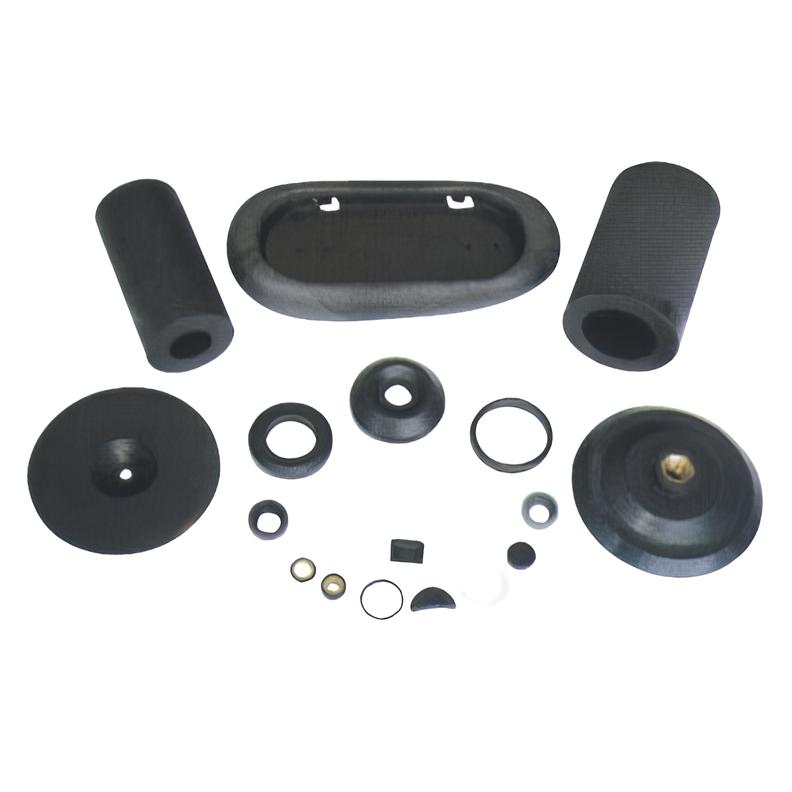Rubber is a versatile material that plays a vital role in various industrial applications. From automotive components to healthcare products, the rubber industry produces a wide array of products that enhance performance, durability, and functionality. But what exactly are the industrial products made from rubber, and how are they created? Let’s explore the vast world of industrial rubber products, the raw materials involved, and the profitability of this thriving industry.

In this article, we will delve into the different types of rubber parts used in industries, the key raw materials that go into rubber manufacturing, and how the rubber industry continues to be a profitable venture.
What are Rubber Parts?
Rubber parts1 refer to various components made from rubber, designed for specific industrial applications. These parts are known for their flexibility, resilience, and durability, making them ideal for a variety of industries such as automotive, aerospace, healthcare, construction, and electronics. Common examples include rubber seals, gaskets, hoses, O-rings, and wheels.
Types of Rubber Parts
| Rubber Part | Common Use | Key Features |
|---|---|---|
| Rubber Seals | Prevent leakage in automotive, aerospace, and industrial systems | Excellent flexibility and sealing ability |
| Rubber Gaskets | Create airtight or watertight seals in machinery | Heat resistance, chemical resistance |
| Rubber Hoses | Transport liquids and gases in industrial systems | High pressure and chemical resistance |
| O-rings | Used in fluid sealing applications in machinery | High resilience and tight sealing ability |
| Rubber Wheels | Transport materials in warehouses or factories | Shock absorption, flexibility, durability |
These rubber parts are typically custom-made to meet specific requirements for different industries, ensuring that they perform effectively under various conditions such as extreme temperatures, high pressure, and exposure to chemicals.
What are the Raw Materials Used in Rubber Industry?
The raw materials used in the rubber industry are fundamental in determining the quality, durability, and performance of rubber products. The primary raw materials used in rubber manufacturing include natural rubber (NR) and synthetic rubber (SR), each having distinct characteristics suitable for various industrial uses.
Key Raw Materials in Rubber Manufacturing
| Raw Material | Description | Application |
|---|---|---|
| Natural Rubber (NR)2 | Derived from latex in rubber trees, used for flexibility and durability | Tires, seals, gaskets, footwear, latex gloves |
| Synthetic Rubber (SR)3 | Man-made rubber produced through chemical processes | Automotive parts, industrial products, medical devices |
| Carbon Black | A reinforcing agent and colorant in rubber production | Tires, rubber products requiring strength |
| Additives (e.g., accelerators, plasticizers) | Used to improve processing and enhance rubber performance | Improve elasticity, temperature resistance, and chemical stability |
Natural Rubber vs. Synthetic Rubber
| Property | Natural Rubber | Synthetic Rubber |
|---|---|---|
| Source | Rubber tree latex | Derived from petroleum |
| Elasticity | Excellent | Varies by type |
| Durability | Moderate | Generally more durable |
| Cost | Relatively expensive | More cost-effective |
Natural rubber is often used in products that require high elasticity, such as tires and rubber bands, while synthetic rubber is typically employed in industrial components like hoses, seals, and gaskets due to its resistance to wear, heat, and oil.
How is Industrial Rubber Made?
The manufacturing of industrial rubber involves a complex process of compounding, mixing, and shaping. The process begins with combining raw rubber materials (natural and synthetic) with additives such as curing agents, carbon black, and accelerators. Once the mixture is prepared, it is subjected to heat and pressure to create the desired rubber product.
The Rubber Manufacturing Process
Compounding: Raw rubber is mixed with chemicals, such as accelerators, curing agents, plasticizers, and fillers like carbon black, to achieve the desired properties.
Molding or Extrusion: The rubber mixture is then shaped into the desired form using molding (for complex shapes) or extrusion (for continuous shapes such as hoses or seals).
Curing or Vulcanization: The rubber is heated to a specific temperature to undergo a chemical reaction (vulcanization4) that strengthens the rubber and gives it its final properties. This is where rubber gains its flexibility, durability, and resistance to wear.
Finishing: After curing, the rubber products are cut, trimmed, or polished to meet precise specifications.
Rubber Manufacturing Equipment
| Equipment | Purpose |
|---|---|
| Banbury Mixers | Mix rubber with additives to form a uniform compound |
| Extruders | Shape rubber into tubes, hoses, and seals |
| Injection Molding | Create complex rubber parts by injecting molten rubber into molds |
| Calendaring Machines | Flatten rubber sheets for flooring and other uses |
How Profitable is the Rubber Industry?
The rubber industry is highly profitable, thanks to its crucial role in many industries such as automotive, construction, and healthcare. According to industry reports, the global rubber market size is expected to grow significantly, driven by increasing demand for tires, industrial products, and advancements in rubber technology.
Factors Driving Profitability in the Rubber Industry
Automotive Demand: The largest consumer of rubber is the automotive industry, particularly for tires, seals, and gaskets, which constitute a significant portion of global rubber consumption.
Technological Advancements: Innovations in rubber compounding, such as the development of eco-friendly tires5, smart rubber, and bio-based rubbers, open new avenues for growth in the industry.
Construction and Healthcare: The demand for rubber products like flooring, seals, and medical devices continues to grow as urbanization and healthcare innovations progress.
Sustainability and Recycling: The push for recycled rubber6 products, especially in tire recycling, is creating new markets for rubber manufacturers.
| Market Segment | Rubber Application | Market Growth Potential |
|---|---|---|
| Automotive | Tires, gaskets, hoses | High demand, steady growth |
| Construction | Flooring, seals, expansion joints | Steady growth with urbanization |
| Healthcare | Gloves, tubing, prosthetics | Increasing demand due to aging populations |
| Recycling | Recycled rubber products | High potential with eco-friendly focus |
The rubber industry remains an attractive market for investors and manufacturers due to its steady demand across diverse sectors and technological advancements that continue to improve product performance.
Conclusion
The rubber industry produces a wide range of essential industrial products used across various sectors, from automotive and healthcare to construction and electronics. The process of making industrial rubber involves compounding, shaping, and curing raw materials to achieve high-performance components. With strong demand driven by industries like automotive and healthcare, and the potential for innovation in recycling and eco-friendly materials, the rubber industry remains both profitable and indispensable to modern manufacturing.
Explore this link to understand the various rubber parts and their specific applications across different industries. ↩
Discover the advantages of natural rubber, including its elasticity and durability, which are crucial for many industrial uses. ↩
Learn about the production process of synthetic rubber and its diverse applications in various industries, enhancing your knowledge of this material. ↩
Learn about vulcanization, a key process that enhances rubber's properties, making it essential for various applications. ↩
Explore the innovative world of eco-friendly tires, which are revolutionizing the rubber industry with sustainable practices. ↩
Discover how recycled rubber is transforming waste into valuable products, promoting sustainability in the rubber industry. ↩







